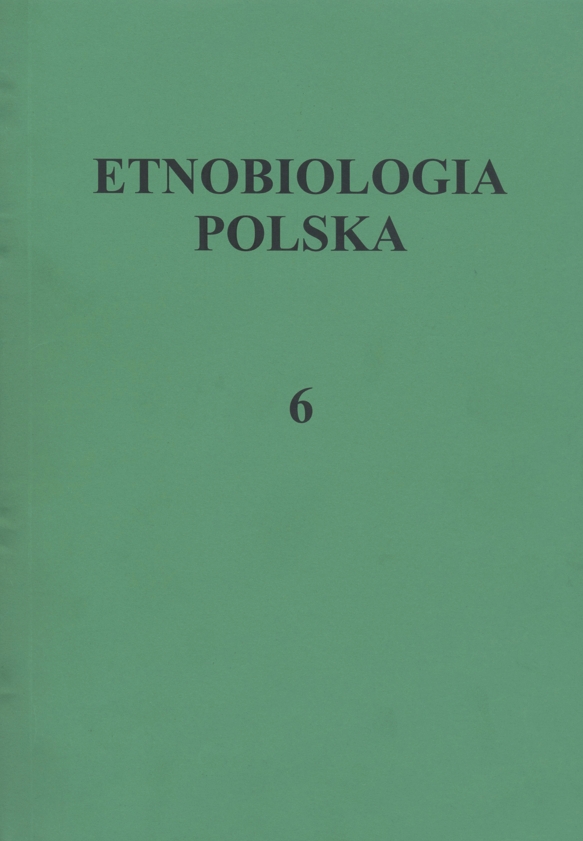Symbole państwowe jako obiekt zainteresowania etnobotaniki – występowanie motywów drzew w symbolach państwowych krajów słowiańskich i ich znaczenie
Słowa kluczowe:
ethnobotany, national symbols, dendrology, SlavsAbstrakt
National symbols are important elements in in the awareness of whole populations nations and are therefore an interesting object for ethnobiological study. In this article we analyzed the issue of the occurrence of tree motifs in the state symbols of Slavic countries. We defined as national symbols: the coat of arms, flag, anthem, coins and banknotes of the country. Trees used to be important for Slavs, not only per se, but as the site of gods or their incarnations. There have been many beliefs, customs and traditions associated with these plants. The two most important trees in Slavic culture are oak and linden. It is interesting that these trees are also the most common of the studied symbols of Slavic countries. Trees do not appear on Slavic flags, rarely in anthems and on coats of arms, and most often on coins and banknotes.
Downloads
Bibliografia
Adrjański Z 1994.Złota księga pieśni polskich: pieśni, gawędy, opowieści. Bellona, Warszawa.
Blench R & Spriggs M 2012. Archaeology and Language III: Artefacts, languages and texts. Routledge, Londyn.
Bogusławski W 1989. Dzieje Słowiańszczyzny północno-zachodniej do połowy XIII wieku, t. 2. Wydawnictwo Armoryka, Sandomierz.
Borecki T 2011. Las a człowiek. Studia i Materiały CEPL w Rogowie 4(29): 11-23.
Cuhaj G S, Michael T, Miller H, McCue D., Danders K 2013. Standard Catalog of World Coins 1901-2000. 40th Edition. Krause Publications, Iola, Wisconsin.
Doroszewski W 2014. Słownik języka polskiego [http://sjp.pwn.pl/slowniki/szlachetno%C5%9B%C4%87.html (01.09.2016 r.)]
Frey L 2013. Drzewo w kulturze ludowej (wybrane zagadnienia). Znak, symbol a rituál v tradíciách a prejavoch ľudovej zbožnosti. Zborník vedeckých (nekonferenčných) štúdií. Prešovská univerzita v Prešove, Prešov.
Galera H 2007. Morfologia a symbolika drzew. Nauka 2: 117-129.
Gloger Z 2013. Dożynki – od pogańskich korzeni do czasów nowożytnych. [online] Merkuriusz polski. Gazeta codzienna. Sztuka, Kultura. Nauka [http://www.poselska.nazwa.pl/wieczorna2/historia-nowozytna/dozynki-od-poganskich-korzeni-do-czasow-nowozytnych (20.07.2016)]
Grzenia J 2002. Słownik imion. Państwowe Wydawnictwo Naukowe, Warszawa.
Grzywacz A 2011. Drzewa jako obiekty kulturowe. Studia i Materiały Centrum Edukacji Przyrodniczo-Leśnej 4(29): 45-62.
Jóźwiak W 2012. Niedźwiedź (2). Taraka – magazyn rozwojowy [http://www.taraka.pl/niedzwiedz_2 (01.09.2016 r.)].
Kaczor I 2001. Kult drzew w tradycji mitologicznej i religijnej starożytnych Greków i Rzymian. Acta Universitatis Lodziensis. Folia Litteraria Polonica 03: 1505-9057.
Kempiński AM 1993. Słownik mitologii ludów indoeuropejskich, Poznań.
Kowalski P 2007. Kultura magiczna. Omen, przesąd, znacznie. Warszawa 2007
Kuçukkomurler S 2011. Olive in culture. Pakistan Journal of Nutrition 10(2): 200-202.
Kuleszewicz R 2001. Słownik symboli literackich. PRINTEX, Białystok.
Kurowski JK 2015. Ekologia i ochrona roślinności leśnej. EKO-GRAF Adam Świć, Łódź.
Łuczaj Ł 1995. Czerwony dąb na polskich monetach. Gazeta Wyborcza 6 (07.01.1995): 4
Łuczaj Ł. 2008. Dziko rosnące rośliny jadalne w ankiecie Józefa Rostafińskiego z roku 1883. Wild food plants in the questionnaire of Józef Rostafiński from 1883. Wiadomości Botaniczne” 52: 39-50
Marczewska M 2001. Aspekty wierzeniowe w rekonstrukcji językowego obrazu drzew. Acta Universitatis Wratislaviensis 2282(16): 83-98.
Michalski B 2012. Międzynarodowa konkurencyjność polskiej gospodarki w perspektywie koncepcji soft power. Prace Naukowe Uniwersytetu Ekonomicznego we Wrocławiu 267(2): 83-94.
Moszyński K 1967. Kultura ludowa Słowian, t. 2. Wydawnictwo Graf-ika, Warszawa.
Olędzki J 1989. Szkice afrykańskie. Zapis filmowy z Archiwum Państwowego Muzeum Etnograficznego w Warszawie.
Ożarowski A & Jaroniewski W 1987. Rośliny lecznicze i ich praktyczne zastosowanie. Instytut Wydawniczy Związków Zawodowych, Warszawa.
Pietrzak E 2015. Historyczne spojrzenie na mistyczne związki ludzi z drzewami. Magazyn antropologiczno-społeczno-kulturowy „Maska” 27: 71-82.
Pollak S 1954. Antologia poezji bułgarskiej. Czytelnik, Warszawa.
Rusew-Sam A 1938. Współczesna poezja bułgarska. Kamena 9-10: 49-50.
Seneta W & Dolatowski J 2008. Dendrologia. Wydawnictwo Naukowe PWN, Warszawa.
Strzelczyk J 2007. Mity, podania i wierzenia dawnych Słowian. Wydawnictwo Rebis, Poznań.
Suder J 2006. Gawędy o drzewach wykorzystywane w edukacji leśnej. Studia i Materiały Centrum Edukacji Przyrodniczo Leśnej 3(13): 221-231.
Tenche-Constantinescu AM, Chira D, Madosa E, Hernea, C, Tenche-Constantinescu RV, Lalescu D, & Borlea GF 2015. Tilia sp.-Urban Trees for Future. Notulae Botanicae Horti Agrobotanici Cluj-Napoca 43(1): 259.
Tyszkiewicz LA 2014. Słowianie. Encyklopedia PWN [http://encyklopedia.pwn.pl/haslo/3976552/slowianie.html (01.09.2016 r.)].
Wojciechowska M (Ed.) 1968. Kosmasa Kronika Czechów. Państwowe Wydawnictwo Naukowe,
Warszawa.
Wójtowicz M 2012. Etnografia Lubelszczyzny – ludowe wierzenia o drzewach. Leksykon Lublin [http://teatrnn.pl/leksykon/node/3232/etnografia_lubelszczyzny_%E2%80%93_ludowe_wierzenia_o_drzewach# (01.09.2016 r.)]
[Kompletný znak Slovenskej republiky, Heraldica.szm.com] http://www.heraldica.szm.com/stranky/slov/indexslov.htm (29.07.2016)]
[Symbole Narodowe Ukrainy, Nieznana Ukraina.pl] http://www.nieznanaukraina.pl/936/symbole-narodowe-ukrainy (29.07.2016)]
Pobrania
Opublikowane
Jak cytować
Numer
Dział
Licencja
Prawa autorskie (c) 2016 Etnobiologia Polska

Utwór dostępny jest na licencji Creative Commons Uznanie autorstwa – Użycie niekomercyjne – Bez utworów zależnych 4.0 Międzynarodowe.


